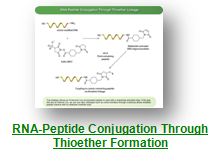High Quality Custom RNA-Peptide Synthesis and Conjugation Services
Bio-Synthesis is committed to Total Quality Management (TQM) to ensure customers' complete satisfaction. MS and HPLC analyses are performed following the completion of RNA, peptide synthesis and cross linking DNA with peptide. QC (quality control) and QA (quality assurance) procedures are also followed independently to double guarantee the high quality of every delivered oligo-peptide conjugate. Bio-Synthesis's has successfully upgraded its Total Quality Management System (TQM) to fully comply with ISO 9001:2008 regulations.
Specification of RNA-Peptide Conjugates
Besides standard RNA-Peptide conjugates, we offer the following:
Price
The price depends on the method used in obtaining peptide-oligo conjugate. Please contact us for a quotation.
Chemistry
Single-stranded oligonucleotides are usually chemically modified by incorporating various nucleoside derivatives, to protect against degradation by serum and cellular nucleases. Double-stranded RNA is generally sufficiently stable in cell culture for non-modification uses, but is also heavily modified with nucleoside analogs for in vivo use.
Methods in preparing peptide-RNA conjugates are post-synthetic conjugation (or post-assembly conjugation and fragment coupling strategy),total stepwise synthesis (or on-line solid phase synthesis), native and template-directed ligations.
There are uses in NHs ester-maleimide mediated conjugation chemistry, such as incorporating peptides and N-terminal Cys to react with a maleimide activated oligo. If the peptide has an internal Cys, we use other strategies such as forming oxime from a hydroxyl-amine modified peptide reating with an aldehyde modified oligo. Although the price for using other strategies for making peptide-oligo conjugate is the same, the price for obtaining other modified peptides, RNA oligo or different cross-linking chemistries that include either stable or cleavable linkages may be higher.

Specification
Product is HPLC purified and usually over 85-95% pure.
Procedure
All RNA and peptide syntheses and conjugation processes are manufactured under strict quality control processes. Analytical HPLC and MS analyses are performed in every development cycle. Final target conjugates must first be isolated from excess or unreacted reagents by gel filtration. Then, size-exclusion chromatography (SEC) or reverse phase (HPLC) may also be used to either remove excess reagent or isolate and characterized the cross-linked product. Once the product has been purified, it may be subject to many different types of studies including spectroscopic (MALDI-TOF,ESI, LC-MS Fluorescence) or electrophoresis studies.
QC (quality control) and QA (quality assurance) procedures are also followed independently to offer you double guarantee for the highest quality possible. Final quantity is systematically validated by UV absorbance at 260 nm. Moreover, our dedicated technical account managers will guide you through every step of the process and constantly keep you informed of the latest project progress.
Delivery Specifications
The typical delivery consists of lyophilized sample in individual, fully labeled vials.The shipment also contains COA, MS, HPLC and/or other analytical data. Additional
analytical data is also available upon request.
Contact our Technical Service Center at 800.227.0627 or contact us online with your detail oligo-peptide project specifications, a project manager will be assigned to help you with design and develop an appropriate synthetic method for
your specific needs.
Ordering and Submitting Requests for Bioconjugation Services
For us to better understand your customized project, please complete our Bioconjugation Service Questionnaire. The more our chemists understand your project’s needs, the more accurate your provided feedback will be. Providing us with your project’s details enables us to recommend the best reagents to use for your project. The most useful and readily available tools for bioconjugation projects are cross-linking reagents. A large number of cross-linkers, also known as bifunctional reagents, have been developed. There are several ways to classify the cross-linkers, such as the type of reactive group, hydrophobicity or hydrophilicity and the length of the spacer between reactive groups. Other factors to consider are whether the two reactive groups are the same or different (i.e. heterobifunctional or homobifunctional reagents), spacer is cleavable and if reagents are membrane permeable or impermeable. The most accessible and abundant reactive groups in proteins are the ϵ-amino groups of lysine. Therefore, a large number of the most common cross-linkers are amino selective reagents, such as imidoesters, sulfo-N-hydroxysuccinimide esters and N-hydroxysuccinimide esters. Due to the high reactivity of the thiol group with N-ethylmaleimide, iodoacetate and a-halocarbonyl compounds, new cross-linkers have been developed containing maleimide and a-carbonyl moieties. Usually, N-alkylmaleimides are more stable than their N-aryl counterparts.
In addition to the reactive groups on the cross-linkers, a wide variety of connectors and spacer arms have also been developed. The nature and length of the spacer arm play an important role in the functionality. Longer spacer arms are generally more effective when coupling large proteins or those with sterically protected reactive side-chains. Other important considerations are the hydrophobicity, hydrophilicity and the conformational flexibility. Long aliphatic chains generally fold on themselves when in an aqueous environment, making the actual distance spanned by such linker arms less than expected. Instead, spacers containing more rigid structures (for example, aromatic groups or cycloalkanes) should be used. These structures, however, tend to be very hydrophobic which could significantly decrease the solubility of the modified molecules or even modify some of their properties. In such cases, it is recommended to choose a spacer that contains an alkyl ether (PEO) chain. Bio-Synthesis offers several cross-linkers with PEO chains, such as thiol-binding homobifunctional reagents, heterobifunctional bases and their derivatives.
Within 3-5 days upon receiving your project scope, we will provide you an appropriate quotation. An order can be placed with PO (Purchase Order) or major credit cards (  ). Your credit card will be billed under Bio-Synthesis, Inc.
). Your credit card will be billed under Bio-Synthesis, Inc.